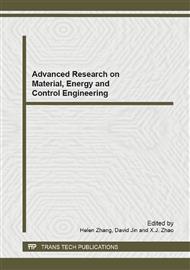[1]
IPCC (Intergovernmental Panel on Climate Change) (2007).
Google Scholar
[2]
Su BD, Xiao B, Zhu DM et al (2005) Trends in frequency of precipitation extremes in the Yangtze River basin, China: 1960-2003. Hydrological Sciences Journal Vol 50(3): 479-492.
DOI: 10.1623/hysj.50.3.479.65022
Google Scholar
[3]
Jiang T, Su BD, Hartmann H (2007) Temporal and spatial trends of precipitation and river flow in the Yangtze River Basin, 1961-2000. Geomorphology 85(3-4): 143-154.
DOI: 10.1016/j.geomorph.2006.03.015
Google Scholar
[4]
Lallahem S, Mania J (2003) A nonlinear rainfall-runoff model using neural network technique: example in fractured porous media. Mathematical and Computer Modelling 37: 1047-1061.
DOI: 10.1016/s0895-7177(03)00117-1
Google Scholar
[5]
Zeng XF, Zbigniew W. Kundzewicz, Zhou JJ et al(2011) Discharge projection in the Yangtze River basin under different emission scenarios based on the Artificial Neural Networks. Quaternary International DOI: 10. 1016/j. quaint. 2011. 06. 009.
DOI: 10.1016/j.quaint.2011.06.009
Google Scholar
[6]
Zhu YM, Lu XX, Zhou Y (2008) Sediment flux sensitivity to climate change: A case study in the Longchuanjiang catchment of the upper Yangtze River, China. Global Planet Change 60: 429-442.
DOI: 10.1016/j.gloplacha.2007.05.001
Google Scholar
[7]
Gao C, Gemmer M, Zeng XF et al (2010) Projected streamflow in the Huaihe River Basin (2010–2100) using artificial neural network. Stochastic Environmental Research and Risk Assessment. Doi: 10. 1007/S00477-009-0355-6.
DOI: 10.1007/s00477-009-0355-6
Google Scholar
[8]
Gardner LR (2009) Assessing the effect of climate change on mean annual runoff. Journal of Hydrology 379: 351-359.
DOI: 10.1016/j.jhydrol.2009.10.021
Google Scholar
[9]
Chiew FHS, Teng J, Vaze J et al (2009) Influence of global climate model selection on runoff impact assessment. Journal of Hydrology 379(1-2): 172-180.
DOI: 10.1016/j.jhydrol.2009.10.004
Google Scholar
[10]
Roeckner E, Bäuml G, Bonaventura L et al (2003) The atmospheric general circulation model ECHAM5. PART I: Model description. Max-Planck-Institute for Meteorology, Hamburg.
Google Scholar
[11]
IPCC (Intergovernmental Panel on Climate Change), 2000. Summary for Policymakers. Special Report on Emissions Scenarios, Cambridge University Press. Cambridge, U K.
Google Scholar
[12]
Hsu K, Gupta HV, Sorooshian S (1995) Artificial neural network modeling of rainfall-runoff process. Water Resources Research 31(10): 2517-2530.
DOI: 10.1029/95wr01955
Google Scholar
[13]
Pan TY, Wang RY, Lai JS (2007) A deterministic linearized recurrent neural network for recognizing the transition of rainfall–runoff processes. Advances in Water Resources 30: 1797-1814.
DOI: 10.1016/j.advwatres.2007.02.009
Google Scholar
[14]
Dawson CW, Harpham C, Wilby RL et al (2002) Evaluation of artificial neural network techniques for flow forecasting in the River Yangtze, China. Hydrology and Earth System Sciences 6: 619-626.
DOI: 10.5194/hess-6-619-2002
Google Scholar
[15]
Hartmann H, Becker S, King L et al (2008) Forecasting water levels at the Yangtze River with neural networks. Erdkunde 62, 231-243.
DOI: 10.3112/erdkunde.2008.03.04
Google Scholar
[16]
Cigizoglu HK (2004) Estimation and forecasting of daily suspended sediment data by multi-layer perceptrons. Advances in Water Resources 27: 185-195.
DOI: 10.1016/j.advwatres.2003.10.003
Google Scholar
[17]
Napolitano G, See L, Calvo B et al (2010) A conceptual and neural network model for real-time flood forecasting of the Tiber River in Rome. Physics and Chemistry of the Earth 35: 187-194.
DOI: 10.1016/j.pce.2009.12.004
Google Scholar
[18]
Han D, Kwong T, Li S (2007) Uncertainties in real-time flood forecasting with neural networks. Hydrological Processes 21: 223-228.
DOI: 10.1002/hyp.6184
Google Scholar
[19]
Bruen M, Yang JQ (2005) Functional networks in real-time flood forecasting—a novel application. Advances in Water Resources 28: 899-909.
DOI: 10.1016/j.advwatres.2005.03.001
Google Scholar
[20]
Maier HR, Dandy GC (2000) Neural network for the prediction and forecasting of water resources variables: a review of modeling issues and applications. Environmental Modelling & Software 15: 101-124.
DOI: 10.1016/s1364-8152(99)00007-9
Google Scholar
[21]
Jiang B, Sun ZH, Liu MQ (2010) China's energy development strategy under the low-carbon economy. Energy 35: 4257-4264.
DOI: 10.1016/j.energy.2009.12.040
Google Scholar
[22]
Wang T, Watson J (2010) Scenario analysis of China's emissions pathways in the 21st century for low carbon transition. Energy Policy 38: 3537-3546.
DOI: 10.1016/j.enpol.2010.02.031
Google Scholar


